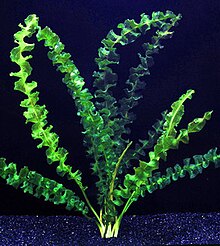Water ears
| Water ears | ||||||||||||
|---|---|---|---|---|---|---|---|---|---|---|---|---|
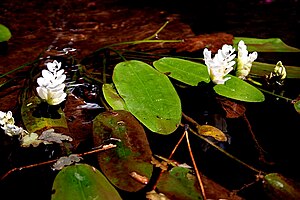
Two-year water ear ( Aponogeton distachyos ) |
||||||||||||
| Systematics | ||||||||||||
|
||||||||||||
| Scientific name of the family | ||||||||||||
| Aponogetonaceae | ||||||||||||
| Planch. | ||||||||||||
| Scientific name of the genus | ||||||||||||
| Aponogetone | ||||||||||||
| L. f. |
The water ears ( Aponogeton ) are the only genus of the family of the water ear plants (Aponogetonaceae) in the order of the frog-spoon-like (Alismatales) within the monocotyledons . The 47 to 59 aquatic plant species have a mainly tropical and subtropical distribution only in the Old World .
Description and ecology

Appearance and leaves
Aponogeton species grow as perennial, herbaceous plants . These aquatic plants that thrive in freshwater have bulbous rhizomes with which they store reserve substances and fibrous roots with which they are anchored in the water bed.
The alternate and spirally arranged leaves on the stem are divided into leaf sheath, petiole and leaf blade. The leaf sheath is open and the petiole is relatively long. The simple leaf blade is broadly elliptical to linear with a few parallel main nerves and many horizontal side nerves. The leaves are submerged and / or flooded; who are not submerged have paracytic stomata . There are more than two scales in the leaf axils.

Inflorescences and flowers
At the end of a flowing, long inflorescence stem stands a simple or two-pronged, spike-like inflorescence ; they only form emersed . They have an attractive bract (spathe), but it is ephemeral early on. Their small, threefold flowers are unisexual or hermaphroditic. The species are either monocial or dioecious . There are often one to six conspicuous white, yellow, mauve or bluish-violet colored bracts , which are often corolla-like and durable. In male or hermaphrodite flowers there are six to many stamens in two to three, rarely four circles. The free stamens are relatively long and thread-like or flattened. The dust bags open with a longitudinal slit. The two to six, rarely up to nine upper carpels are free or at most fused at their base. Each carpel contains two to eight anatropic ovules . The stylus is relatively short.
Pollination takes place by insects ( beetles or Hymenoptera , entomophilia ). Many species are self-fertile.
Fruits and seeds
The follicles stand together in a collective fruit. The follicles contain four seeds. The relatively large (50 to 75 millimeters) seeds are spread out floating over the water. The seeds contain a straight embryo and no endosperm .
Chromosome numbers
The basic chromosome numbers are x = 8.
Importance in the aquarium hobby
A number of water spikes species and varieties are cultivated in the aquarium hobby, with some species being very demanding and difficult to maintain. Only a few species are available for planting in aquariums in pet shops . Some species are feral from aquarium keeping in some countries.
Systematics and distribution
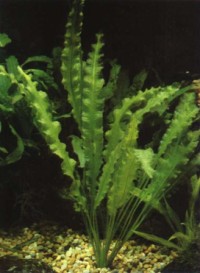

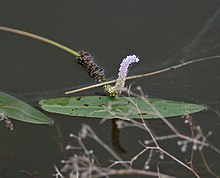
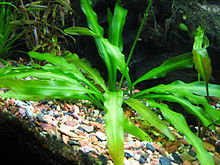
The generic name Aponogeton was first published in 1782 by Carl von Linné the Younger in Supplementum Plantarum , 32, p. 214. The type species is Aponogeton monostachyon L. f. A synonym for Aponogeton L. f. is Urirandra Thouars ex Mirb. , Uvirandra J.St.-Hil. , Hydrogeton Pers. , Ouvirandra Thouars .
The surname Aponogetonaceae was published in 1856 by Jules Émile Planchon in Botanical Magazine , Volume 82, ad Tab. 4894. The publication of Jacob Georg Agardh in Theoria Systematis Plantarum ... , 44 did not take place until 1858.
The genus Aponogeton (anagrammatically derived from the generic name Potamogeton ) has a mainly tropical to subtropical distribution only in the Old World . The main areas of biodiversity are Madagascar (15 species), South Africa (nine species) and Australia (twelve species). There are also species in Asia and tropical Africa.
The genus water ears ( Aponogeton ) contains about 47 to 59 species:
- Abyssinian water ear ( Aponogeton abyssinicus Hochst. Ex A.Rich. ): It is distributed from Ethiopia via Kenya , Tanzania , Uganda , Rwanda , the Democratic Republic of the Congo to Malawi .
- Aponogeton afroviolaceus Lye : It is distributed from Kenya via Tanzania and Zambia to Zimbabwe.
- Aponogeton angustifolius Aiton (Syn .: Aponogeton crinifolius Lehm. Ex Schltdl. ): It occurs only in the South African province of Western Cape .
- Aponogeton appendiculatus H.Bruggen : It occurs in western and southern India .
- Aponogeton azureus H.Bruggen : It is only known from the type location in Ovamboland in northern Namibia .
- Bernier's water ear ( Aponogeton bernierianus (Decne.) Hook. F. , Syn .: Aponogeton quadrangularis Baker ): It occurs in Madagascar only in the eastern provinces of Fianarantsoa and Toamasina . The cultivation of this species in the aquarium has only been successful in isolated cases.
- Aponogeton bogneri H.Bruggen : It occurs only in the southern Democratic Republic of the Congo .
- Boivin's water ear ( Aponogeton boivinianus Baill. Ex Jum. ): It occurs in Madagascar only in the northern province of Antsiranana .
- Aponogeton bruggenii S.R. Yadav & Govekar : It occurs only in western India.
- Aponogeton bullosus H.Bruggen : Thespecies first describedby the Dutch botanist Heinrich Wilhelm Eduard van Bruggen (1927-2010) in 1969 only thrives on the Atherton Tablelands in Queensland, Australia.
- Aponogeton capuronii H. Bruggen : It occurs in Madagascar only in the southern province of Toliara .
- Aponogeton cordatus Jum. : It occurs in Madagascar only in the Toamasina province.
- Krause water ear ( Aponogeton crispus Thunb. ): It is distributed from Sri Lanka to southern India to Bangladesh .
- Aponogeton cuneatus S.WLJacobs : The species described by the botanist Surrey Wilfrid Laurance Jacobs (1946–2009) occurs only in Queensland .
- Aponogeton dassanayakei Manaw. & Yakand. : The species first described in 2016 occurs in Sri Lanka.
- Decary's water ear ( Aponogeton decaryi Jum. Ex Humbert ): The species named after Raymond Decary is common in Madagascar in the provinces of Antananarivo , Fianarantsoa, Mahajanga and Toliara.
- Aponogeton desertorum Zeyh. ex explos. : It iswidespreadfrom the southern Democratic Republic of the Congo to southern Africa ( Angola , Zambia , Zimbabwe , South Africa). In South Africa it occurs in the provinces of Eastern Cape , Limpopo and North West .
- Aponogeton dioecus Bosser : In Madagascar it occurs only in the central province of Antananarivo.
- Two-year water ear ( Aponogeton distachyos L. f. ): Originally only found in the South African province of Western Cape . It is a neophyte in Australia, New Zealand, South America, and Western Europe .
- Aponogeton eggersii Bogner & H.Bruggen : It occurs in Madagascar only in the Toamasina province.
- Long-leaved water ear ( Aponogeton elongatus F.Muell. Ex Benth. ): Of the two subspecies, one occurs only in Queensland and the other from northern Australia to northeastern New South Wales .
- Aponogeton euryspermus Hellq. & SWLJacobs : It is distributed from northern Western Australia to the Northern Territory .
- Aponogeton fotianus J.Raynal : It occurs only in southwestern Chad .
- Aponogeton fugax J.C. Manning & Goldblatt : It was first described in 2008. It is a floral element of the Capensis in the South African provinces of the Western Cape and the North Cape . It has isolated occurrences from the Bokkeveld Escarpment to Agulhas Plain. The stocks are decreasing, which is why it is rated in the Red List of Endangered Plant Species in South Africa 2010 as "Endangered".
- Aponogeton god near Kasselm. & Bogner : It was first described in 2008 from Madagascar.
- Aponogeton hexatepalus H.Bruggen : It is common in southwestern Australia.
- Jacobsen's water ear ( Aponogeton jacobsenii de Wit ): It occurs only in central Sri Lanka.
- Aponogeton junceus clay. ex Schltdl. : It iswidespreadfrom the southern Democratic Republic of the Congo to southern Africa .
- Aponogeton kannangarae M.A. Silva, Deshaprema & Manamperi : The species first described in 2016 occurs in Sri Lanka.
- Aponogeton kimberleyensis Hellq. & SWLJacobs : It occurs only in northern Western Australia .
- Aponogeton lakhonensis A.Camus (Syn .: Aponogeton pygmaeus Krause , Aponogeton taiwanensis Masamune ): The wide distribution area extends from India , Laos , Cambodia , Thailand , Malaysia , Vietnam and the Chinese provinces of Fujian , Guangdong , Guangxi , Hainan , Jiangxi , Yunnan , Zhejiang to Taiwan and Indonesia .
- Aponogeton lancesmithii Hellq. & SWLJacobs : It only occurs in Queensland.
- Aponogeton longiplumulosus H.Bruggen : It has a disjoint area in Madagascar and occurs there only in the provinces of Antsiranana and Mahajanga.
- Loria's water ear ( Aponogeton loriae Martelli ): The plant, named after the naturalist Lamberto Loria , only occurs in southeastern New Guinea .
- Lattice plant ( Aponogeton madagascariensis (Mirb.) H. Bruggen , Syn .: Aponogeton fenestralis (Pers.) Hook. F. , Aponogeton guillotii upper right ): It is widespread in Madagascar in the provinces of Antananarivo, Fianarantsoa, Mahajanga and Toamasina.
- Aponogeton masoalaensis Bogner : It was first described in 2002 from Madagascar.
- Aponogeton natalensis olive. (Syn .: Aponogeton junceus subsp. Natalense (Oliv.) Oberm. ): It is distributed in the South African provinces of Eastern Cape , Gauteng , KwaZulu-Natal , Limpopo, Mpumalanga and North West.
- Floating water ear ( Aponogeton natans (L.) Engl. & K.Krause ): It occurs in Sri Lanka and India .
- Aponogeton nateshii S.R.Yadav : The 2015 first described species occurs in India.
- Aponogeton nudiflorus Peter : It is distributed from Ethiopia via Somalia and Kenya to Tanzania.
- Aponogeton proliferus Hellq. & SWLJacobs : It only occurs in Queensland.
- Aponogeton queenslandicus H.Bruggen : It occurs only in Queensland.
- Aponogeton ranunculiflorus Jacot Guill. & Marais It thrives in the Drakensberg in KwaZulu-Natal and Lesotho .
- Aponogeton rehmannii Oliv. : It is widespread from Kenya to the South African provinces of Free State, Gauteng, Limpopo, Mpumalanga and North West.
- Stiff-leaved water ear ( Aponogeton rigidifolius H.Bruggen ): It occurs in southwestern Sri Lanka.
- Robinson's water ear ( Aponogeton robinsonii A.Camus ): It occurs only in central and southern Vietnam and was named after C. Robinson (1871-1913).
- Aponogeton satarensis Sundararagh., ARKulk. & SRYadav : It only occurs in western India.
- Aponogeton schatzianus Bogner & H.Bruggen : It occurs only in Madagascar in the province of Fianarantsoa.
- Aponogeton stuhlmannii Engl .: It is common from Kenya to Namibia and the South African provinces of Gauteng, Limpopo, Mpumalanga and North West.
- Aponogeton subconjugatus Schumach. & Thonn. : It is distributed from tropical West Africa to Uganda .
- Fine-spiked Wasserähre ( Aponogeton tenuispicatus H.Bruggen ): You only comes in Madagascar in the province of Antsiranana and forms, in contrast to most Aponogeton species a rhizome.
- Aponogeton tofus S.WLJacobs : It occurs only in the Northern Territory in South Africa.
- Aponogeton troupinii J.Raynal : It occurs only in southern Chad and in the northern Democratic Republic of the Congo.
- Sea lettuce-like water ear ( Aponogeton ulvaceus Baker , Syn .: Aponogeton ambongensis Jum. ): It is widespread in Madagascar in the provinces of Antananarivo, Antsiranana, Mahajanga, Toamasina and Toliara.
- Wavy water ear ( Aponogeton undulatus Roxb. ): It is distributed from northern India to Indochina and occurs in Johor and Borneo .
- Aponogeton vallisnerioides Baker : It is common in tropical Africa.
- Aponogeton vanbruggenii Hellq. & SWLJacobs : It occurs in the Australian states of Northern Territory and Queensland.
- Aponogeton viridis Jum. : It occurs only in Madagascar in the province of Mahajanga.
- Aponogeton wolfgangianus S.R. Yadav : The species first described in 2017 occurs in the Indian state of Kerala.
- Aponogeton womersleyi H.Bruggen : It occurs in southern New Guinea.
swell
- The family of Aponogetonaceae in APWebsite. (Sections Description and Systematics)
- The Aponogetonaceae family at DELTA by L. Watson & MJ Dallwitz. (Section description)
- Youhao Guo, Robert R. Haynes & C. Barre Hellquist: Aponogetonaceae . In: Wu Zheng-yi, Peter H. Raven & Deyuan Hong (Eds.): Flora of China . Acoraceae-Cyperaceae. Volume 23. Science Press and Missouri Botanical Garden Press, Beijing et al. 2010, ISBN 978-1-930723-99-3 , pp. 104 (English, " Aponogetonaceae - Online " - online text is identical to the printed work; printed work - full text online). (Section description, systematics and dissemination)
- C. Barre Hellquist & Robert R. Haynes: Aponogetonaceae. - Same text online as the printed work , In: Flora of North America Editorial Committee (Ed.): Flora of North America North of Mexico. Volume 22: Magnoliophyta: Alismatidae, Arecidae, Commelinidae (in part), and Zingiberidae, Oxford University Press, New York / Oxford et al. 2000, ISBN 0-19-513729-9 . (Section description)
- Leslie Watson, 2008: Entry in the Western Australian Flora . (Sections Description and Systematics)
Individual evidence
- ↑ Christel Kasselmann : Plant aquariums design , Franckh-Kosmos Verlag, Stuttgart 2001, ISBN 3-440-08518-X .
- ↑ Christel Kasselmann: aquarium plants. Ulmer Verlag, Stuttgart 1999, ISBN 3-8001-7454-5 .
- ↑ L. f. Scanned in 1782 at biodiversitylibrary.org .
- ↑ a b Aponogetonaceae at Tropicos.org. Missouri Botanical Garden, St. Louis, accessed July 3, 2014.
- ↑ a b c d e f g h i j k l m n Aponogetonaceae at Tropicos.org. In: Catalog of the Vascular Plants of Madagascar . Missouri Botanical Garden, St. Louis
- ↑ a b c d e Aponogetonaceae in the Germplasm Resources Information Network (GRIN), USDA , ARS , National Genetic Resources Program. National Germplasm Resources Laboratory, Beltsville, Maryland. Retrieved July 4, 2014.
- ^ Planchon scanned in 1856 at biodiversitylibrary.org .
- ↑ Christel Kasselmann: aquarium plants. 1999, p. 116.
- ↑ Directory of African species: Aponogeton enter in search.
- ↑ a b c d e f g h i j k l m n o p q r s t u v w x y z aa ab ac ad ae af ag ah ai aj Rafaël Govaerts (Ed.): Aponogeton. In: World Checklist of Selected Plant Families (WCSP) - The Board of Trustees of the Royal Botanic Gardens, Kew . Retrieved April 14, 2020.
- ↑ a b c d e f g h i Species list for Aponogeton in the Red List of South African Plants
- ↑ a b c Walter Erhardt , Erich Götz, Nils Bödeker, Siegmund Seybold: The great pikeperch. Encyclopedia of Plant Names. Volume 2. Types and varieties. Eugen Ulmer, Stuttgart (Hohenheim) 2008, ISBN 978-3-8001-5406-7 .
- ^ Peter Goldblatt, John C. Manning, EJJ Sieben & JP Roux: Aponogetonaceae. Aponogeton fugax, a new endemic species from the Cape floral region, South Africa , In: Bothalia , Volume 38, 2008, pp. 156–159.
- ↑ Christel Kasselmann: aquarium plants. 1999, p. 128.
- ↑ Christel Kasselmann: aquarium plants. 1999, p. 133.
- ↑ Christel Kasselmann: aquarium plants. 1999, p. 134.
Supplementary literature
- Heinrich Wilhelm Eduard van Bruggen : Monograph of the genus Aponogeton (Aponogetonaceae) , In: Bibliotheca Botanica , 1985, VIII, Heft 137, ISBN 3-510-48008-2 .
- Christel Kasselmann : aquarium plants . Ulmer Verlag, Stuttgart 1995; 2nd edition 1999, ISBN 3-8001-7454-5 , pp. 109-136.
Web links
- Aponogetonaceae at Tropicos.org. In: IPCN Chromosome Reports . Missouri Botanical Garden, St. Louis
